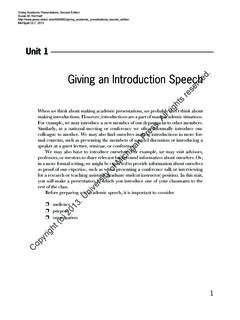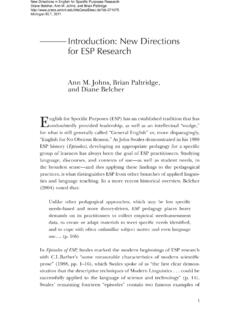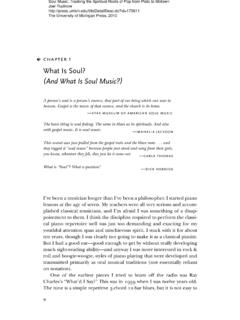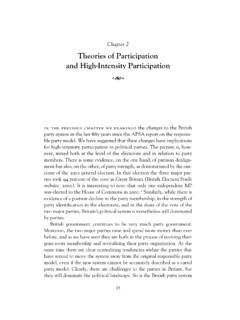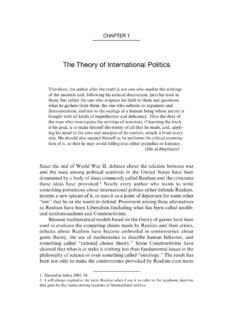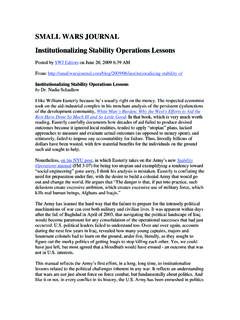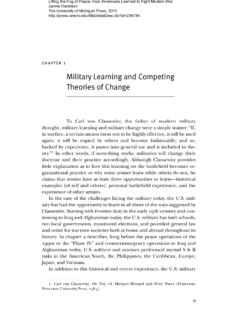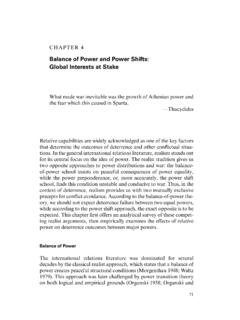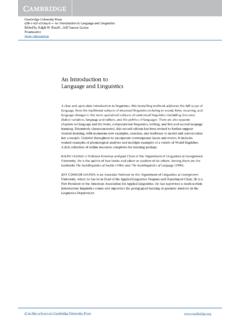Transcription of Chapter 1
1 Chapter introduction to Linguistics11 PreliminariesLinguistics is the science that studies language. Someone who studies lin-guistics is a linguist. Notice that there is a common understanding of the word linguist as meaning someone who knows many languages. While it is often true that linguists know several languages, being a polyglot ( , some-one who knows many languages) is not a requirement for being a linguist. Note that in the definition above we have talked about language, not a specific language (say, English) or a group of languages. To a large extent, all languages in the world are based on similar principles. Part of our goal will be to outline such principles. The other purpose of this book (and of this course) is to make you appreciate the complexity (and the beauty) of language as well as the complex relations between the speakers, their societ-ies, and their Principles All languages of the world share some design features (see Figure ).
2 Lan-guages share some general organizational mechanisms that distinguish them from other forms of communication, such as the systems of communication developed by animals and insects. While many animal communication sys-tems may share some of these features, none has them Language Structure, Interaction, and Variation, Third Ed.: an introduction to Applied Linguistics and Sociolinguistics for Nonspecialists Steven Brown, Salvatore Attardo, and Cynthia Vigliotti Michigan ELT, 2014 Copyright (c) 2014. University of Michigan Press. All rights reserved. 2 Understanding Language, Third : Eight Design Features of LanguagesDouble articulationLanguage uses a small number of sounds (less than 50 in most languages) that are combined to produce a large, but finite, number of words, which can be combined in an infinite number of sentences. ProductivityLanguage can produce novel sentences that have never been uttered is no necessary connection between sound and meaning: the meaning dog and the English word dog are connected arbitrarily as proven by the existence of the word chien in French, which expresses roughly the same individual can both be a speaker and a hearer.
3 DisplacementLanguage can be used to talk about things that are not present or do not exist. Language can also be used to differences between language units are of an all-or-nothing kind: a sound cannot be heard as something in between a b or a p requires only a limited part of the speaker s behavior/attention and is independent of its transmissionNot all aspects of language are innate; some are taught after birth and differ according to the culture the child is reared Language Structure, Interaction, and Variation, Third Ed.: an introduction to Applied Linguistics and Sociolinguistics for Nonspecialists Steven Brown, Salvatore Attardo, and Cynthia Vigliotti Michigan ELT, 2014 Copyright (c) 2014. University of Michigan Press. All rights reserved. 1: introduction to Linguistics 3 The Subfields of LinguisticsThe fields in which linguistics is traditionally divided are: zPhonetics deals with the sounds of language. zPhonology deals with how the sounds are organized.
4 ZMorphology deals with how sounds are put together to form words. zSyntax deals with how sentences are formed. zSemantics deals with the meanings of words, sentences, and texts. zPragmatics deals with how sentences and texts are used in the world ( , in context). zText linguistics deals with units larger than sentences, such as paragraphs and texts ( , any message, large or small, simple or complex, expressed through language).Several other fields within linguistics that look at language from the perspective of another discipline include: zSociolinguistics (language in society) zPsycholinguistics (psychology of language) zAnthropological linguistics (anthropology of language, ethnolinguistics) zHistorical linguistics (the history of languages) zNeurolinguistics (language and the brain) zLanguage pedagogy (how to teach languages; its best-known field is English as a second/foreign language) zComputational linguistics (computers and language) zMany others, such as forensic linguistics (language and the law) and translation.
5 Understanding Language Structure, Interaction, and Variation, Third Ed.: an introduction to Applied Linguistics and Sociolinguistics for Nonspecialists Steven Brown, Salvatore Attardo, and Cynthia Vigliotti Michigan ELT, 2014 Copyright (c) 2014. University of Michigan Press. All rights reserved. 4 Understanding Language, Third to Knowdouble articulationproductivityarbitrarinessint erchangeabilitydisplacementdiscretenesss pecializationcultural transmissionReview ..1. Explain: All languages in the world are based on similar What evidence in this unit tells you that linguistics is primarily concerned with speech? Which subfields might be useful for investigating literacy?Approaches to LanguageThe following sections will outline different ways in which a linguist, or a knowledgeable amateur, may approach language. The sections will cover the prescriptive and descriptive approaches, the historical approach (with a few hints at the origins of linguistics as a historical discipline), and the very important competence-versus-performance distinction.
6 The last sec-tion rounds the Chapter off with a discussion of the scientific method as it applies to the study of Language Structure, Interaction, and Variation, Third Ed.: an introduction to Applied Linguistics and Sociolinguistics for Nonspecialists Steven Brown, Salvatore Attardo, and Cynthia Vigliotti Michigan ELT, 2014 Copyright (c) 2014. University of Michigan Press. All rights reserved. 1: introduction to Linguistics 5 Prescriptive vs. DescriptiveYou have been using, but also studying, language for much of your grammar rules do you remember from school? Make a list. After you have read this section, try to decide whether the rules you remember are prescriptive or descriptive can look at language from two points of view: zPrescriptivism consists basically of stating what is con-sidered right and wrong in language. It passes judg-ments for example, splitting infinitives is wrong. This means that To boldly go where no one has gone is a bad sentence because it splits the infinitive to go.
7 ZDescriptivism, on the other hand, consists of describing the facts, as in, some people split infinitives, and some don t. Which kind of people split infinitives? When do they do that? What can be used to split an infinitive?A common misunderstanding is that descriptivists have no rules and that they have a permissive anything goes attitude. In fact, noth-ing could be further from the truth. Descriptive linguistics is dedicated to describing the rules of the language, and language is seen as essentially rule-governed (that is, made of rules). So what is the issue? Don t descriptivists and prescriptivists agree? In fact, prescriptivists and descriptivists disagree deeply: descriptiv-ists seek to find the rules that govern the languages spoken by people ( , English, French, Chinese, Swahili, and all others), while prescriptivists, for the major part, seek to impose arbitrary rules that come from outside the language and/or seek to preserve a stage of the language that has been left behind by the evolution of the language itself.
8 Understanding Language Structure, Interaction, and Variation, Third Ed.: an introduction to Applied Linguistics and Sociolinguistics for Nonspecialists Steven Brown, Salvatore Attardo, and Cynthia Vigliotti Michigan ELT, 2014 Copyright (c) 2014. University of Michigan Press. All rights reserved. 6 Understanding Language, Third example, the prescription of the avoidance of the split infinitive was based on the fact that Latin avoided doing so, when Latin was thought of as a better language than English. Often prescriptivists are merely cling-ing to a past state of the language. For example, the distinction between who and whom is now lost on most speakers. There isn t anything anyone can do, practically speaking, to restore this distinction. What prescriptivists say is often not supported by linguistic data. For example, a common claim of prescriptivists is that the double negative (I don t want no fish) should be banned. English has always had the double negative.
9 Shakespeare uses it in Romeo and Juliet, III, i (Mercutio: I will not budge for no man s pleasure). So why do people get so upset about prescriptivism? Perhaps because following certain grammatical rules is a social shibboleth. A shibboleth provides information about the group to which individuals belong. The word shibboleth comes from the Bible (Judges, 12:6), where it is used by the Gileadites to distinguish themselves from the Ephraimites, who pronounced it sibboleth. Once the Gileadites sorted themselves out from the Ephraimites, they killed their usage helps gather information about someone. If you do or say something in a certain way, you belong to a certain group. Follow-ing or not following certain linguistic forms may be used to identify a social class or ethnic group. For example, African-American Vernacular English (AAVE) eliminates the copula in certain syntactic constructions, roughly whenever Informal English allows contractions (In It s, s is the contracted form of is, the third-person singular form of the copula).
10 So, They are home would be They home in AAVE (see Chapter 7 for a fuller discussion). This elimination of the copula and other features of AAVE may be perceived as unprofessional or as ignorant, while in fact, they are signs of a speaker speaking a different dialect. Because of various historical reasons (essen-tially, the history of discrimination against African Americans), the AAVE dialect is considered less prestigious than other dialects; therefore, speakers Understanding Language Structure, Interaction, and Variation, Third Ed.: an introduction to Applied Linguistics and Sociolinguistics for Nonspecialists Steven Brown, Salvatore Attardo, and Cynthia Vigliotti Michigan ELT, 2014 Copyright (c) 2014. University of Michigan Press. All rights reserved. 1: introduction to Linguistics 7 will associate negative impressions, such as those noted, with it. In other words, the dialect a speaker uses marks him or her socially.
